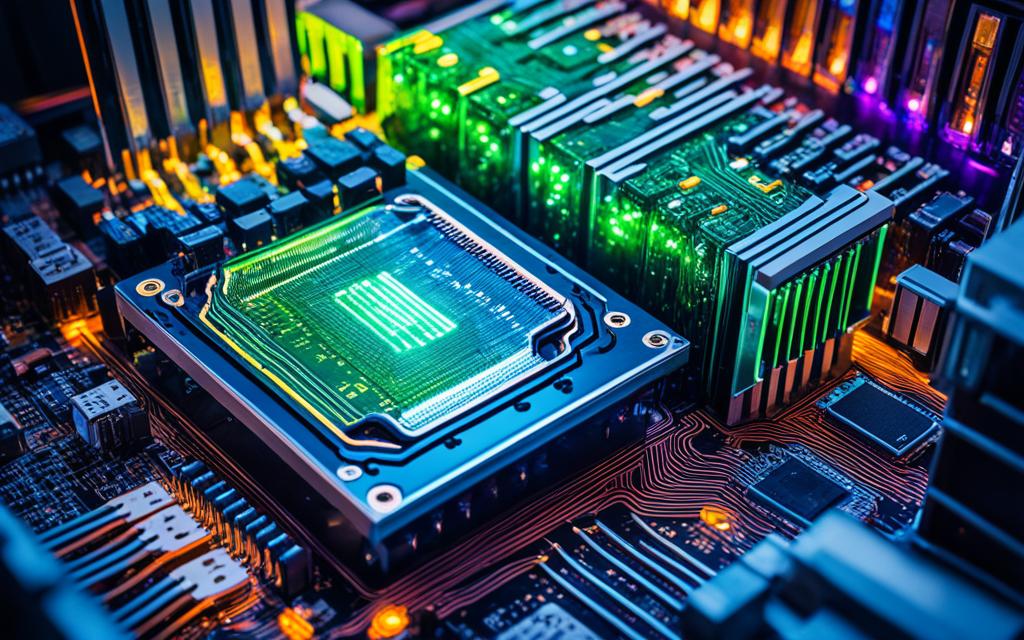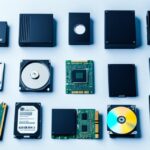Table of Contents
Primary storage, also known as main memory, is crucial in computers. It stores data, programs, and instructions in use. With the global data storage market1 set to hit $50 billion by 2024, its importance is clear. This component is key for fast access and processing, allowing computers to read and write quickly. It includes volatile and non-volatile memory. Volatile memory loses data when power is off, while non-volatile memory keeps data safe even when the device is off.
Businesses depend on quick data management, making primary storage understanding crucial. The link between bits and bytes shows the core of computer memory. Bytes are vital for representing and handling information. Knowing about these units aids in managing storage and data efficiently.
Key Takeaways
- Primary storage is crucial for immediate data access and processing capabilities.
- It comprises both volatile and non-volatile memory types.
- The global data storage market is expected to exceed $50 billion by 2024.
- Fast access to data enhances overall computing performance.
- Solid-state drives are increasingly used for their superior speed in primary storage.
- Understanding bytes and bits is essential for effective data management.
- Primary storage directly supports an organisation’s operational efficiency.
What is Primary Storage?
Understanding the definition of primary storage is crucial for knowing how computers handle data. It refers to the main memory essential for quick data access during active tasks. This makes it a key part of a smooth-running computer system.
Definition and Purpose
Primary storage includes different technologies that offer fast data access. It uses memory types like RAM, SSDs, and SAN solutions. Organisations rely on it to store data that’s used often, such as transactional data or important application information2. Technologies like SAN and NAS are great for speedy data access. They’re especially good for database management2.
Comparison with Secondary Storage
Primary and secondary storage differ greatly, mainly in how often the data is accessed. Secondary storage keeps data that’s not used regularly, like backups2. It’s cheaper but slower than primary storage2. Still, with new tech like all-flash arrays, primary storage is now even faster. It’s better for important applications in need of quick responses3.
Importance of Primary Storage in Computing Systems
Primary storage is key in today’s computers. It helps them work fast and handle data well. Being quick to fetch data is crucial, as it boosts how the system works. Organisations benefit from getting data fast. For them, primary storage cuts down delays, which is vital for apps like database management that need quick access.
Fast Access to Data
Data needs to be reached quickly for apps to run smoothly and systems to load fast. Primary storage has parts that save data temporarily and permanently. RAM, a temporary part, speeds up operations. It lets the CPU get to processes swiftly, improving how the system performs. This speed is a big step up from slower secondary storage45.
Support for Speedy Processing
For top performance, primary storage is essential. It helps with important tasks in crucial apps. By using primary storage, systems can handle changing tasks better. This leads to using resources more wisely. Knowing how primary storage helps is key to getting more done and easy multitasking in today’s computing world3.
Types of Primary Storage in Computers
It’s crucial to understand the different types of primary storage to know how computers work well. Primary storage includes various kinds of electronic memory, each for specific uses. Among them, Read Only Memory (ROM) and Random Access Memory (RAM) are key. They show the main difference between memory that keeps data always (non-volatile) and memory that only holds data when powered (volatile). This difference is important for the computer’s speed and how quickly it can get data.
Read Only Memory (ROM)
ROM is a type of memory that doesn’t lose data when the computer turns off. It’s vital for the basic system startup information. ROM comes in several forms like Programmable ROM (PROM), Erasable Programmable ROM (EPROM), Electrically Erasable Programmable ROM (EEPROM), and Mask ROM (MROM). Each type has special features for different needs6.
Random Access Memory (RAM)
RAM, on the other hand, can read and write data fast, no matter where the data is. But it’s volatile, meaning data goes away when there’s no power. RAM includes Static RAM (SRAM) and Dynamic RAM (DRAM). SRAM is quicker but must have power all the time to keep data. DRAM, however, needs to be refreshed regularly to keep its data. These differences affect both their speed and cost67.
Other Forms of Primary Storage
There are more types of primary storage, like cache memory. It’s super quick and sits between RAM and the CPU to speed up data access. Flash memory is also key, offering non-volatile storage that you can erase and use again. It’s great for various electronic gadgets6. These different memory types make sure every part of a computer works its best. This lets users do their tasks fast and well.
Understanding RAM: A Critical Component
Random Access Memory (RAM) is key in computers, boosting performance and how it handles data. It comes chiefly in two types: SRAM and DRAM, each important for different reasons.
What is SRAM?
Static Random Access Memory (SRAM) stands out for its speed and stability. It’s quicker than DRAM because it doesn’t need refreshing. This makes it perfect for quick data access, like in CPU caches. SRAM costs more and takes up more space per bit than DRAM8. Yet, its efficiency in power use is notable, especially in high-performance computing9.
What is DRAM?
Dynamically Random Access Memory (DRAM) is common in today’s devices. It keeps data in capacitors and refreshes it every 64 milliseconds, offering a vast data storage capacity910. This RAM is vital for heavy tasks such as gaming or video editing. For everyday use, at least 8 GB of RAM is recommended, but 16 GB is better for tougher jobs8. Technology improvements in DDR (Double Data Rate) have improved DRAM’s speed and energy use, from DDR to DDR58.
Operational Advantages of Primary Storage
The key benefits of primary storage are vital for improving computer systems. A major point is data caching and buffering, which boosts efficiency.
Data Caching and Buffering
Primary storage speeds up access to often-used data through smart caching. The cache memory keeps frequently needed instructions for quick loading and processing. This boosts data efficiency. By handling the buffering process well, primary storage lessens delays. It ensures a steady flow of data from the hard drive to the CPU. This process is key for reducing the speed gaps seen during data handling, crucial in today’s computing.
Enhancing Performance
Primary storage also raises system speed by allowing fast data access. It’s much quicker than secondary storage, needing only microseconds to access data. Such speed is crucial as CPU tasks happen in nanoseconds. Thus, it helps avoid any delay in processing. With enhanced access and capabilities of RAM and ROM, it improves how computers work on various tasks. Discover more about these differences. Hence, the perks of primary storage are critical not just for now but also for long-term tasks11512.
Primary Storage of a Computer: Media Types and Technologies
Today, computer storage mainly uses two technologies: Solid-State Drives (SSDs) and Hard Disk Drives (HDDs). They’re key for storing, accessing, and using data in computers.
Solid-State Drives (SSDs)
SSDs have changed the game by offering faster speeds than HDDs. They use flash memory, which lets them access data quickly. This means your computer starts up and opens programs faster. SSDs also use less power and are lighter, making them great for laptops and tablets. They come in sizes from 150GB to several terabytes. Plus, SSDs can read and write data much faster than HDDs1314.
Hard Disk Drives (HDDs)
HDDs are not as fast as SSDs, but they still have their place. They have spinning disks and arms that read and write data, which slows them down. However, they offer more storage for less money. This makes them good for storing lots of data without spending a lot. HDDs can hold from a few hundred gigabytes to many terabytes of data13.
Conclusion
Primary storage is key in computing systems, vital for data management and boosting performance. It helps CPUs use RAM to run programs quickly. Furthermore, cache memory plays an essential role, as highlighted in the primary storage summary. The move towards SSD technology marks a trend for faster data access and improved efficiency.
The outlook for primary storage is promising, with new solutions enhancing connectivity and data handling. Innovations in SRAM and DRAM are driving speed and reliability forward. We’re entering a new phase of digital exploration151617.
The interplay between primary and secondary storage will keep influencing user experiences and efficiency across different fields. As digital shifts occur, acknowledging these developments is crucial for staying ahead15.
FAQ
What is primary storage and why is it essential for computers?
Primary storage, also known as main memory, is key because it stores currently used data and instructions. It allows quick data access, boosting processing and performance.
How does primary storage differ from secondary storage?
Primary storage offers quick data access for system tasks, unlike secondary storage which holds less frequently used data. This difference outlines their unique roles in computers.
What are the benefits of using primary storage in computing systems?
Using primary storage results in fast data access. This enhances computing speed and efficiency. It makes sure systems run smoothly, especially for demanding applications.
What types of primary storage are available?
Available primary storage types include ROM, which keeps data without power, and volatile RAM. There’s also flash memory and cache, which enable fast data access.
What is the difference between SRAM and DRAM?
SRAM, used for caching, is faster than DRAM. DRAM is common and cheaper, fitting modern computing. Each type is crucial for primary storage in RAM.
How does primary storage improve operational efficiency?
Primary storage boosts efficiency by fast data caching and buffering. This reduces data retrieval times, vital for seamless computing.
What are the different media types used in primary storage?
The key media types are SSDs, for speedy access and durability, and HDDs, which are slower but offer more storage affordably. The system’s needs dictate the choice.
Why is the transition from HDDs to SSDs important?
Switching from HDDs to SSDs matters because SSDs are faster, more durable, and cost-effective. This move marks a major development in storage, influencing computing’s future.
Source Links
- https://www.arcserve.com/blog/primary-storage-vs-secondary-storage-whats-difference – Primary Storage vs. Secondary Storage: What’s the Difference?
- https://www.techtarget.com/searchstorage/definition/primary-storage – What is Primary Storage? – Definition from WhatIs.com
- https://www.purestorage.com/knowledge/primary-vs-secondary-storage.html – Primary Storage vs. Secondary Storage: What’s the Difference? | Pure Storage
- https://www.siyavula.com/read/za/computer-applications-technology/grade-11/storage-memory-and-processing-devices/03-storage-memory-and-processing-devices – 3.1 Storage devices | Storage, memory and processing devices
- https://www.geeksforgeeks.org/primary-memory/ – Primary Memory – GeeksforGeeks
- https://www.shiksha.com/online-courses/articles/about-primary-storage-devices/ – All About Primary Storage Devices – Shiksha Online
- https://www.studysmarter.co.uk/explanations/computer-science/computer-organisation-and-architecture/primary-storage/ – Primary Storage: Types & Importance
- https://www.techtarget.com/searchstorage/definition/RAM-random-access-memory – What is RAM (random access memory)? | Definition from TechTarget
- https://www.crucial.com/articles/about-memory/support-what-does-computer-memory-do – What Does Computer Memory (RAM) Do?
- https://www.primescholars.com/articles/understanding-random-access-memory-ram-a-crucial-component-of-computing-124176.html – Prime Scholars | Open Access Journals | Peer Reviewed Journals
- https://www.linkedin.com/pulse/exploring-computer-storage-types-advantages-drawbacks-mohindroo- – Exploring Computer Storage: Types, Advantages, and Drawbacks
- https://www.geeksforgeeks.org/difference-between-primary-and-secondary-memory/ – Difference between Primary and Secondary Memory – GeeksforGeeks
- https://en.wikipedia.org/wiki/Computer_data_storage – Computer data storage
- https://www.geeksforgeeks.org/what-is-a-storage-device-definition-types-examples/ – What is a Storage Device? Definition, Types, Examples – GeeksforGeeks
- https://unacademy.com/content/bank-exam/study-material/computer-knowledge/notes-on-primary-storage/ – Notes on Primary Storage
- https://www.tutorchase.com/answers/ib/computer-science/what-are-the-limitations-of-primary-memory-in-computing – What are the limitations of primary memory in computing? | TutorChase
- https://www.prepbytes.com/blog/general/what-is-primary-and-secondary-memory/ – What is Primary and Secondary Memory?








